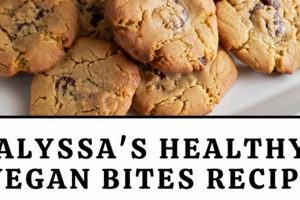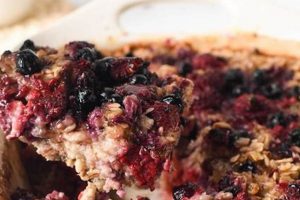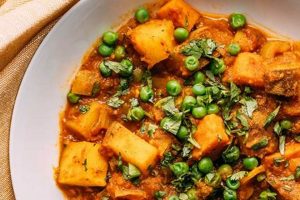Dietary strategies that mitigate inflammation and exclude all animal products offer a specific approach to nutrition. These plans focus on incorporating plant-based foods known for their anti-inflammatory properties, such as leafy greens, berries, nuts, seeds, and certain spices. A meal consisting of a lentil soup with turmeric and ginger, alongside a salad with mixed greens and a flaxseed oil dressing, exemplifies this approach.
The adoption of this nutritional framework may contribute to overall well-being by addressing underlying inflammatory processes within the body. Historically, plant-based diets have been associated with reduced risk factors for chronic diseases. The potential benefits stem from the high concentration of antioxidants and phytonutrients found in plant-derived foods, which play a role in neutralizing free radicals and modulating immune responses.
Subsequent sections will delve into specific food groups that are central to achieving this dietary pattern, explore the science behind their purported benefits, and provide guidance on effectively implementing these principles into daily meal planning. Furthermore, practical considerations regarding potential nutrient deficiencies and strategies for ensuring a balanced and complete nutritional profile will be addressed.
Implementation Strategies for Plant-Based Anti-Inflammatory Nutrition
The following recommendations offer guidance on effectively integrating plant-based foods with anti-inflammatory properties into daily dietary habits.
Tip 1: Prioritize Whole, Unprocessed Foods: Base meals around whole grains, legumes, vegetables, fruits, nuts, and seeds. Minimizing processed foods reduces exposure to additives and refined ingredients that may exacerbate inflammation.
Tip 2: Incorporate Omega-3 Fatty Acids: Consume foods rich in omega-3 fatty acids, such as flaxseeds, chia seeds, walnuts, and hemp seeds. These fats play a crucial role in modulating inflammatory pathways.
Tip 3: Emphasize Colorful Fruits and Vegetables: Include a variety of colorful fruits and vegetables in each meal. Different pigments represent distinct antioxidants, which collectively contribute to neutralizing free radicals and reducing oxidative stress.
Tip 4: Utilize Anti-Inflammatory Spices: Incorporate spices known for their anti-inflammatory properties, such as turmeric, ginger, garlic, and cinnamon. These spices contain bioactive compounds that can influence inflammatory processes.
Tip 5: Ensure Adequate Fiber Intake: Consume sufficient dietary fiber from sources like vegetables, fruits, legumes, and whole grains. Fiber supports a healthy gut microbiome, which plays a significant role in regulating inflammation.
Tip 6: Focus on Hydration: Maintain adequate hydration by drinking water throughout the day. Dehydration can contribute to inflammation, while adequate hydration supports optimal cellular function.
Tip 7: Prioritize Sleep and Stress Management: Alongside dietary considerations, prioritize adequate sleep and effective stress management techniques. Sleep deprivation and chronic stress can exacerbate inflammatory responses.
These implementation strategies aim to provide a framework for adopting a plant-based dietary pattern that may contribute to managing inflammatory processes within the body. Consistent application of these principles, combined with a healthy lifestyle, may support overall well-being.
The subsequent section will address potential challenges associated with this dietary approach and provide guidance on ensuring comprehensive nutritional adequacy.
1. Turmeric Curcumin
Turmeric, a spice derived from the Curcuma longa plant, is frequently incorporated into anti-inflammatory vegan recipes due to the purported medicinal properties of its active compound, curcumin. Its relevance stems from curcumin’s potential to modulate inflammatory pathways, offering a natural adjunct to dietary strategies designed to alleviate chronic inflammation.
- Bioavailability Enhancement
Curcumin’s bioavailability is limited due to poor absorption and rapid metabolism. Vegan recipes often address this by combining turmeric with black pepper, which contains piperine, a compound known to significantly enhance curcumin absorption. An example includes incorporating turmeric and black pepper into lentil soups or vegetable curries.
- Inflammatory Pathway Modulation
Curcumin has demonstrated the ability to inhibit several key inflammatory mediators, including cytokines, enzymes, and transcription factors. This action can potentially reduce the severity of inflammatory conditions. Vegan dishes utilizing turmeric, such as golden milk (prepared with plant-based milk) or spiced tofu scrambles, aim to leverage this effect.
- Antioxidant Properties
Curcumin exhibits antioxidant properties, which contribute to its anti-inflammatory action by neutralizing free radicals and reducing oxidative stress. This is particularly beneficial in a vegan context, where the diet may already be rich in other antioxidants from fruits and vegetables. Examples include adding turmeric to smoothies or roasted vegetables.
- Dosage Considerations
Achieving therapeutic doses of curcumin through dietary intake alone can be challenging. Many anti-inflammatory vegan recipes incorporate relatively high quantities of turmeric, but supplementation may be necessary to achieve desired effects. However, it’s essential to consult healthcare professionals before using curcumin supplements due to potential interactions with medications.
The strategic use of turmeric and curcumin within vegan recipes provides a dietary avenue for potentially mitigating inflammation. While bioavailability enhancement and dosage considerations remain important factors, the integration of this spice reflects a focus on leveraging natural compounds to support overall well-being. Further research remains necessary to fully elucidate the long-term effects of curcumin consumption in specific populations and conditions.
2. Omega-3 Sources
The incorporation of omega-3 fatty acids into plant-based diets is a significant consideration for formulating nutritional strategies aimed at mitigating inflammation. Omega-3 fatty acids, specifically alpha-linolenic acid (ALA), eicosapentaenoic acid (EPA), and docosahexaenoic acid (DHA), play a crucial role in modulating inflammatory responses within the body. While EPA and DHA are primarily found in marine sources, plant-based alternatives provide ALA, which can be converted to EPA and DHA, albeit with varying efficiency.
- Alpha-Linolenic Acid (ALA) Conversion
Plant-based sources of omega-3 fatty acids primarily provide ALA, a precursor to EPA and DHA. However, the conversion rate of ALA to EPA and DHA is often limited by factors such as enzymatic activity and individual physiology. Vegan recipes frequently incorporate ALA-rich foods like flaxseeds, chia seeds, walnuts, and hemp seeds, aiming to increase overall omega-3 intake and, consequently, EPA and DHA production. Supplementation with algae-derived EPA and DHA offers a more direct route for increasing these omega-3s.
- Inflammatory Pathway Modulation
Omega-3 fatty acids influence inflammation by modulating the production of eicosanoids, signaling molecules derived from fatty acids. EPA and DHA, in particular, can lead to the production of less inflammatory eicosanoids compared to those derived from omega-6 fatty acids. This shift in eicosanoid production may contribute to a reduction in chronic inflammatory processes. For example, including flaxseed oil in salad dressings or smoothies introduces ALA, potentially influencing eicosanoid balance.
- Omega-6 to Omega-3 Ratio
Maintaining a balanced ratio of omega-6 to omega-3 fatty acids is considered important for managing inflammation. Diets high in omega-6 fatty acids, commonly found in processed foods and certain vegetable oils, may promote inflammation. Vegan recipes often emphasize omega-3 sources while limiting processed foods and oils high in omega-6s, aiming to improve the overall fatty acid profile. Utilizing olive oil or avocado oil, lower in omega-6, can aid in achieving optimal ratio.
- Cardiovascular Benefits
Beyond their anti-inflammatory properties, omega-3 fatty acids are associated with cardiovascular health benefits. Vegan recipes incorporating these fats may contribute to reducing risk factors for heart disease, such as high triglycerides and blood pressure. Dishes such as oatmeal with walnuts and chia seeds or flaxseed-crusted tofu offer dual benefits by providing both anti-inflammatory compounds and heart-healthy fats.
The strategic integration of omega-3 sources into vegan recipes represents a proactive approach to managing inflammation and promoting overall health. While ALA conversion rates may vary, consistent consumption of ALA-rich foods, coupled with potential EPA and DHA supplementation, supports a plant-based nutritional strategy aimed at mitigating chronic inflammatory conditions and supporting cardiovascular well-being. Further research is necessary to fully define optimal omega-3 intake levels for different individuals and specific inflammatory conditions.
3. Fiber Richness
Dietary fiber, abundant in plant-based foods, plays a critical role in modulating the inflammatory response within the body. Its inclusion in anti-inflammatory vegan recipes is not merely an adjunct but a fundamental component for achieving desired outcomes. The following facets highlight key mechanisms through which fiber impacts inflammatory processes.
- Gut Microbiome Modulation
Dietary fiber serves as a primary substrate for the gut microbiome. Undigested fiber reaches the colon, where it is fermented by bacteria, producing short-chain fatty acids (SCFAs) like butyrate, acetate, and propionate. Butyrate, in particular, has demonstrated anti-inflammatory properties by enhancing gut barrier function and modulating immune cell activity. Vegan recipes rich in whole grains, legumes, and vegetables facilitate this process, fostering a beneficial gut environment. For example, a hearty lentil soup or a quinoa salad with assorted vegetables provides ample fiber to support SCFA production.
- Regulation of Blood Sugar and Insulin
Fiber slows down the absorption of glucose, mitigating postprandial blood sugar spikes and reducing insulin resistance. Elevated blood sugar levels and insulin resistance contribute to systemic inflammation. Anti-inflammatory vegan recipes prioritize low-glycemic index (GI) and high-fiber foods to stabilize blood sugar and reduce inflammatory markers. Examples include swapping refined grains for whole grains or including beans and legumes in meals, offering sustained energy release and minimizing inflammatory responses.
- Reduction of Systemic Inflammation
Soluble fiber binds to bile acids in the small intestine, promoting their excretion and reducing cholesterol levels. Lowering cholesterol, particularly LDL cholesterol, can reduce inflammation associated with atherosclerosis. Furthermore, fiber may directly interact with immune cells, modulating their activation and reducing the production of pro-inflammatory cytokines. A diet high in soluble fiber from sources such as oats, beans, and fruits can contribute to lower systemic inflammation and improved overall health. For instance, a breakfast of oatmeal with berries and flaxseeds provides a significant source of soluble fiber.
- Promotion of Bowel Regularity
Adequate fiber intake promotes regular bowel movements, preventing constipation and the buildup of toxins in the digestive tract. Constipation can lead to increased intestinal permeability, allowing bacterial products to enter the bloodstream and trigger an inflammatory response. By promoting regularity, fiber helps maintain gut integrity and reduce systemic inflammation. Vegan recipes incorporating a variety of fiber-rich foods, such as fruits, vegetables, and whole grains, ensure optimal bowel function and contribute to an anti-inflammatory environment.
The mechanisms underscore the importance of fiber in the context of anti-inflammatory vegan recipes. Through microbiome modulation, blood sugar regulation, systemic inflammation reduction, and promotion of bowel regularity, fiber exerts a multifaceted influence on inflammatory processes, supporting a holistic approach to dietary management. The emphasis on whole, plant-based foods in these recipes inherently ensures a high fiber intake, optimizing potential health benefits.
4. Antioxidant Density
Antioxidant density, referring to the concentration of antioxidant compounds within a food, is a critical determinant of the anti-inflammatory potential of plant-based diets. The fundamental connection arises from the role of antioxidants in neutralizing free radicals, unstable molecules that contribute to oxidative stress and inflammation. Anti-inflammatory vegan recipes intentionally leverage this connection by incorporating foods with high antioxidant levels. Oxidative stress, triggered by an imbalance between free radical production and antioxidant defense, damages cells and tissues, initiating and perpetuating inflammatory cascades. Plant-based foods rich in antioxidants, such as berries, leafy greens, and colorful vegetables, counteract this process by donating electrons to stabilize free radicals, thereby reducing oxidative damage and mitigating inflammation. Without adequate antioxidant intake, the body’s capacity to manage oxidative stress is compromised, potentially exacerbating inflammatory conditions.
Examples of antioxidant-dense vegan recipes include smoothies incorporating mixed berries, spinach, and flaxseeds; salads featuring kale, red cabbage, and bell peppers with a citrus-based dressing; and curries utilizing turmeric, ginger, and various vegetables. Each component contributes specific antioxidants. Berries are rich in anthocyanins, leafy greens provide carotenoids, and spices like turmeric contain curcumin. The synergistic effect of these compounds amplifies the overall antioxidant capacity of the meal, enhancing its anti-inflammatory impact. Furthermore, the cooking methods employed can influence antioxidant retention. Steaming or lightly sauting vegetables, rather than boiling, helps preserve heat-sensitive antioxidants. Additionally, including healthy fats, such as olive oil or avocado, can improve the absorption of fat-soluble antioxidants like carotenoids.
In summary, antioxidant density serves as a key parameter in the formulation of anti-inflammatory vegan recipes. These dietary approaches are designed to maximize the intake of antioxidant compounds, thereby neutralizing free radicals and reducing oxidative stress. Understanding the relationship between antioxidant density and inflammatory processes empowers individuals to make informed food choices. However, individual needs and responses to dietary changes may vary, necessitating a personalized approach to nutritional planning. Further research continues to explore the specific roles of different antioxidants and their interactions within the context of complex dietary patterns.
5. Cruciferous Vegetables
Cruciferous vegetables, a family encompassing broccoli, cauliflower, kale, Brussels sprouts, and cabbage, are frequently highlighted in anti-inflammatory vegan recipes due to their unique bioactive compounds. These vegetables contain glucosinolates, sulfur-containing compounds that, when broken down during chewing and digestion, produce isothiocyanates. Isothiocyanates, such as sulforaphane, have demonstrated anti-inflammatory and antioxidant properties. Their inclusion in plant-based diets is a deliberate strategy to leverage these effects, potentially mitigating chronic inflammatory processes. The consumption of cruciferous vegetables is linked to the modulation of inflammatory pathways, influencing the production of cytokines and other inflammatory mediators.
For example, a broccoli and kale salad with a lemon-tahini dressing provides a blend of glucosinolates and antioxidants. Sauted Brussels sprouts with garlic and a touch of chili flakes offer another avenue for incorporating these vegetables. The practical significance lies in the accessibility and versatility of cruciferous vegetables, allowing for their integration into diverse culinary preparations. However, it is crucial to note that cooking methods can impact the bioavailability of isothiocyanates. Steaming or lightly stir-frying cruciferous vegetables preserves more glucosinolates compared to boiling, which can leach these compounds into the water. Furthermore, individuals with thyroid conditions should exercise moderation in cruciferous vegetable consumption, as they contain goitrogens that can interfere with thyroid hormone production.
In summation, the strategic incorporation of cruciferous vegetables into anti-inflammatory vegan recipes is supported by the presence of glucosinolates and their derivative isothiocyanates. These compounds contribute to the overall anti-inflammatory potential of the diet, alongside other plant-based components. While cooking methods and individual health conditions warrant consideration, the consistent inclusion of cruciferous vegetables represents a practical and accessible approach to dietary management of inflammation. Further research may explore the synergistic effects of combining different cruciferous vegetables and their impact on specific inflammatory markers.
6. Processed-Food Avoidance
The avoidance of processed foods is a cornerstone of anti-inflammatory vegan dietary strategies. This approach directly addresses the elimination of ingredients and compounds known to exacerbate inflammatory responses within the body. Processed foods frequently contain high levels of refined sugars, unhealthy fats, sodium, and artificial additives, all of which can trigger inflammatory pathways. The consumption of these substances promotes oxidative stress, disrupts the gut microbiome, and impairs immune function, thereby contributing to chronic inflammation. A diet centered on whole, unprocessed plant-based foods, by contrast, provides a naturally dense array of antioxidants, phytonutrients, and fiber, all working in concert to counter inflammatory processes. The significance of avoiding processed foods is thus not merely additive, but rather essential for realizing the intended anti-inflammatory effects of a vegan dietary pattern. Real-life examples include individuals with inflammatory bowel disease experiencing symptom relief after transitioning from a diet high in processed foods to a whole-food vegan diet; similarly, those with rheumatoid arthritis may observe reduced joint pain and stiffness when they eliminate processed foods and embrace plant-based meals rich in vegetables, fruits, legumes, and whole grains.
Practical applications of this understanding necessitate a critical examination of food labels and a conscious shift toward home cooking and meal preparation. Recognizing hidden sources of processed ingredients, such as refined oils in salad dressings or added sugars in plant-based milks, is paramount. Constructing meals from scratch using whole ingredients allows for greater control over dietary composition and ensures the exclusion of potentially inflammatory additives. Strategies such as batch cooking, meal prepping on weekends, and stocking pantries with staples like beans, lentils, and whole grains facilitate the sustained adoption of a processed-food-free vegan diet. Furthermore, mindful eating practices, coupled with an understanding of the impact of food choices on bodily functions, enhance adherence to this dietary approach.
In summary, the avoidance of processed foods is an indispensable component of anti-inflammatory vegan diets. By eliminating ingredients known to promote inflammation and emphasizing whole, plant-based alternatives, this approach supports a balanced immune response, reduces oxidative stress, and fosters overall well-being. Challenges to adopting this lifestyle may include time constraints and limited access to fresh produce; however, proactive planning and informed decision-making can overcome these obstacles. Processed-food avoidance complements and amplifies the benefits of other key elements within anti-inflammatory vegan recipes, such as turmeric consumption, omega-3 intake, and fiber enrichment, creating a synergistic effect that promotes optimal health.
Frequently Asked Questions
This section addresses common inquiries regarding the implementation and efficacy of dietary strategies that mitigate inflammation using solely plant-based foods.
Question 1: Do anti-inflammatory vegan recipes effectively reduce chronic inflammation?
The effectiveness of such recipes depends on adherence to core principles. A consistent focus on whole, unprocessed plant foods, coupled with the strategic inclusion of anti-inflammatory ingredients like turmeric and omega-3 sources, may contribute to reduced inflammatory markers. However, individual responses vary and medical consultation remains advisable.
Question 2: Can a vegan diet, designed to reduce inflammation, meet all nutritional needs?
A carefully planned vegan diet can be nutritionally complete. However, attention must be paid to potential deficiencies in nutrients such as vitamin B12, vitamin D, iron, calcium, iodine, and omega-3 fatty acids. Supplementation or fortified foods may be necessary to address these concerns.
Question 3: How can one maximize the anti-inflammatory benefits of plant-based recipes?
Maximizing benefits involves combining multiple strategies: prioritizing whole, unprocessed foods; incorporating spices like turmeric and ginger; ensuring adequate omega-3 intake from flaxseeds or walnuts; including a diverse range of colorful fruits and vegetables; and avoiding refined sugars, processed oils, and artificial additives. Cooking methods that preserve nutrient content are also important.
Question 4: Are there specific foods that should be avoided in an anti-inflammatory vegan diet?
Foods known to promote inflammation should be limited or avoided. These include refined sugars, processed oils (such as corn and soybean oil), trans fats, and heavily processed plant-based meat substitutes. Emphasis should be placed on whole, minimally processed alternatives.
Question 5: How quickly can one expect to see results from adopting an anti-inflammatory vegan diet?
The timeline for experiencing noticeable results varies depending on individual factors, such as the severity of inflammation, underlying health conditions, and adherence to the dietary plan. Some individuals may experience improvements within a few weeks, while others may require several months. Consistency is essential.
Question 6: Is an anti-inflammatory vegan diet suitable for all individuals?
While generally safe, this dietary approach may not be suitable for everyone. Individuals with specific medical conditions, such as kidney disease or certain gastrointestinal disorders, should consult with a healthcare professional or registered dietitian before making significant dietary changes. Children, pregnant women, and breastfeeding mothers have unique nutritional needs that warrant careful consideration.
Adopting a plant-based approach requires a degree of diligence and knowledge. Its ability to mitigate inflammation relies on conscious food selections.
The subsequent section will explore sample recipes that embody these principles.
Conclusion
The preceding sections have explored the nuances of anti-inflammatory vegan recipes, highlighting the significance of specific plant-based ingredients and dietary strategies. The careful selection of foods rich in omega-3 fatty acids, antioxidants, and fiber, coupled with the avoidance of processed items, constitutes a framework for managing systemic inflammation through dietary means.
The potential benefits of implementing these principles warrant serious consideration for individuals seeking to modulate inflammatory processes. Further research and personalized nutritional guidance remain essential for optimizing outcomes and ensuring nutritional adequacy. The integration of these dietary strategies represents a proactive approach to supporting long-term health and well-being.







